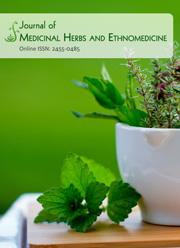Qualitative analysis of some bioactive components of methanolic leaf extract of M. citrifolia (Noni)
DOI:
https://doi.org/10.25081/jmhe.2020.v6.6102Keywords:
Bioactive compounds; M. citrifolia; Methanol; PhytochemicalsAbstract
Medicinal plants offer endless opportunities for new drugs discovery due to their supremacy for the possession of phytochemicals compounds known for diverse antimicrobial activities. The world ever increasing demand for therapeutic drugs from natural products with particular interest in edible plants for safety purposes is now catching researchers’ attention. This study therefore aimed at determining the presence of some bioactive phytochemical components of methanolic leaf extract of M. citrifolia L. Qualitative screening of leaf extract has confirmed the existence of Tannins, steroids, saponins, flavonoids and alkaloids in the mixture. And these bioactive compounds correspond to phytochemicals with antimicrobial, nematicide, pesticidal, antioxidant, ant-inflammatory, cytotoxic, anti-allergy, and anti-carcinogenic properties (bioactive compounds) earlier documented by previous researchers.
Downloads
References
2. Madhumitha, G., Rajakumar, G., Roopan, S. M., Rahuman, A. A., Priya, K. M., Saral, A. M., and Kamaraj, C. Acaricidal, insecticidal, and larvicidal efficacy of fruit peel aqueous extract of Annona squamosa and its compounds against blood-feeding parasites. Parasitology Research. 2012;111:(5),2189-2199.
3. Singh, S. Enhancing phytochemical levels, enzymatic and antioxidant activity of spinach leaves by chitosan treatment and an insight into the metabolic pathway using DART-MS technique. Food Chemistry. 2016;199:176-184.
4. Cos, P., Vlietinck, A. J., Berghe, D. V., and Maes, L. Anti-infective potential of natural products: how to develop a stronger in vitro ‘proof-of-concept’. Journal of Ethnopharmacology. 2006;106 (3):290-302.
5. Idris, F. M., Ibrahim, A. M., and Forsido, S. F. Essential oils to control Colletotrichum musae in vitro and in vivo on banana fruits. American-Eurasian Journal of Agricultural and Environmental Science. 2015;15(3):291-302.
6. Sasidharan, S., Chen, Y., Saravanan, D., Sundram, K. M., and Latha, L. Y. Extraction, isolation and characterization of bioactive compounds from plants’ extracts. African Journal of Traditional, Complementary and Alternative Medicines. 2011; 8(1):1-10.
7. Kumar, S., Samydurai, R., and Nagarajan, N. Gas chromatography and mass spectrometry analysis of bioactive constituents of Adiantum Capillus-veneris L. International Journal of Pharmacy and Pharmaceutical Sciences. 2014;6: 60-63.
8. Compean, K. L., and Ynalvez, R. A. Antimicrobial activity of plant Secondary metabolites: A Review. Research Journal of Medicinal Plants. 2014;8(5):204 -13.
9. Kumar, G. S., Jayaveera, K. N., Kumar, C. K., Sanjay, U. P., Swamy, B. M., and Kumar, D. V. Antimicrobial effects of Indian medicinal plants against acne-inducing bacteria. Tropical Journal of Pharmaceutical Research. 2007; 6(2): 717-723.
10. Bur?ová, Z., Kreps, F., Greifová, M., Jablonský, M., Ház, A., Schmidt, Š. and Šurina, I., Antibacterial and antifungal activity of phytosterols and methyl dehydroabietate of Norway spruce bark extracts. Journal of Biotechnology. 2018; 282:18-24.
11. Mubiu, J.K., Ndwigah, S.N., Abuga, K.O. and Ongarora, D.S. Antimicrobial activity of extracts and phytosterols from the root bark of Lonchocarpus eriocalyx. East and Central African Journal of Pharmaceutical Sciences. 2017;20(1-3):13-16.
12. Parekh, J., and Chanda, S. Antibacterial and phytochemical studies on twelve species of Indian medicinal plants. African Journal of Biomedical Research. 2007;10(2): 175-181.
13. Onwukaeme DN, Ikuegbvweha TB, Asonye CC. Evaluation of phytochemical constituents, antibacterial activities and effect of exudate of Pycanthus Angolensis weld warb (Myristicaceae) on corneal ulcers in rabbits. Tropical Journal of Pharmaceutical Research. 2007;6(2):725-30.
14. Harborne, J. B. Twenty-five years of chemical ecology. Natural product reports. 2001; 18(4): 361-379.
15. Gul, R., Jan, S. U., Faridullah, S., Sherani, S., and Jahan, N. Preliminary Phytochemical Screening, Quantitative Analysis of Alkaloids, and Antioxidant Activity of Crude Plant Extracts from Ephedra intermedia Indigenous to Balochistan. The Scientific World Journal. 2017; 2017(Special Issue).
16. Yahia EM, editor. Postharvest biology and technology of tropical and subtropical fruits: Mangosteen to white sapote. Elsevier; 2011 Jun 30.
17. Wang, M. Y., and Su, C. Cancer preventive effect of Morinda citrifolia (Noni). Annals of the New York Academy of Sciences. 2001; 952(1): 161-168.
18. Nair, R. and Chanda, S. Antibacterial activities of some medicinal plants of the western region of India. Turkish Journal of Biology. 2007;31(4):231-236.
19. Somani, S. J., Modi, K. P., Majumdar, A. S., and Sadarani, B. N. Phytochemicals and their potential usefulness in inflammatory bowel disease. Phytotherapy Research, 2015; 29(3): 339-35.
20. Sharma G, Prakash D, Gupta C, Prakash D, Sharma G. Phytochemicals of nutraceutical importance: do they defend against diseases. Phytochemicals of Nutraceutical Importance. 2014;28;1.
21. Morrissey, J. P., and Osbourn, A. E. Fungal resistance to plant antibiotics as a mechanism of pathogenesis. Microbiology and Molecular Biology Reviews. 1999; 63(3):708-724.
22. Okwu D. E. Phytochemicals, Vitamins and Mineral contents of two Nigeria Medicinal plants. International Journal of Molecular Medicine and Advance Sciences. 2005;1(4): 375-381.
23. Biresaw G, Mittal KL. Surfactants in Tribology, 2 Volume Set. CRC Press; 2011 Jun 17.



 .
. 